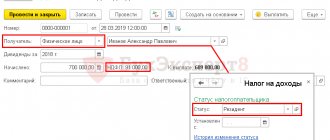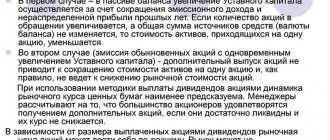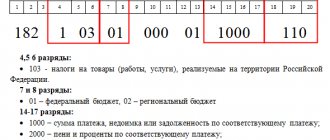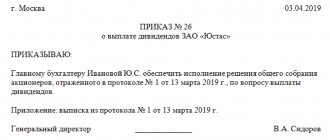Differences in calculating dividends under different tax regimes
Comparative table combining all tax regimes for LLCs:
| simplified tax system | UTII | Unified agricultural tax | BASIC | |
| Dividend calculation | Dividends are paid from profits after paying a “simplified” tax - depending on the regime - 6% or 5–15%; Payment of dividends for the second type of regime is not a reason to include it in the “expenses” column and thereby reduce the tax base | Dividends are distributed among the founders based on the accounting report data | Taxation of dividends occurs according to Articles 346.5–346.15 of the Tax Code of the Russian Federation | Dividends are accrued based on the results of the first three months, half a year and year. Source: net income. Distributed among the founders according to the charter, otherwise - according to the share in the authorized capital of the LLC |
| Calculation of personal income tax and income tax | For a resident (individual, organization) – 13% of the amount; For other persons (foreign citizens and enterprises) – 15% | |||
Important! If a Russian company owns half a share or more of it in the authorized capital of a company for 365 days before the order to pay dividends, then no tax is paid on the amount of profit.
The procedure for paying dividends and withholding tax on dividends
The actual payment of dividends is subject to tax withholding. Tax rates on the amount of dividends paid:
- 13% - “NDFL”, if the founder is an individual and is a citizen of the Russian Federation;
- 15% - “NDFL”, if the founder is an individual and is a non-resident of the Russian Federation;
- 13% - income tax if the founder is a legal entity and is a Russian company;
- 15% - income tax if the founder is a legal entity and is a foreign company;
- 0% – A Russian organization that owns at least a 50% share in the management company of the LLC paying dividends for at least 365 calendar days before the date of the decision to pay dividends.
For information
From 01/01/2021, a 0% rate is established in relation to dividends received by some international holding companies, and a 5% rate in relation to dividends received by foreign persons on shares (stakes) of international holding companies ( subparagraph a, paragraph 4, article 2 of the Law dated 03.08.2021 N 294-FZ ).
Dividend tax is calculated using the following formula: Tax amount = Dividend amount * tax rate
Payment of the calculated tax on dividends must be made no later than the 1st business day following the day of payment, regardless of who the dividends are paid to or to the individual. person or legal entity.
The accrual and payment of dividends is usually accompanied by reporting, which is submitted to the tax authorities.
– when calculating “personal income tax” in the form of a certificate in the form of certificates “2-NDFL;
-report in form “6-NDFL;
- “LIST-03” and the corresponding sections to it (“section 1.3”) of the corporate income tax declaration are submitted by all legal entities, including tax agents who apply other taxation regimes (for example, “STS”).
Calculation of dividends under the simplified tax system
The procedure for paying dividends is determined by the following documents:
- Tax code.
- Federal Law No. 14 “On LLC”.
- Charter of the enterprise.
- Minutes of the meeting of the founders of the company.
When preparing the charter, participants must take care to draw up the following points:
- restrictions on the distribution of dividends (additional conditions not specified in the law under which payment cannot be made);
- the procedure for dividing profits - taking into account the proportionality of investments or according to another scheme.
On the balance sheet, dividends are distributed in the column “Retained income” (1370). According to simplified accounting reports, the company’s net income on the simplified tax system can be found out by the balance of account 84 “Uncovered loss, Retained income.” Data for this year – “Net income/loss” (line 2400). When paying dividends to participants, the company, which is on the simplified tax system, is considered a tax agent in relation to profits and personal income tax. Consequently, the enterprise must withhold and transfer these taxes to the state budget.
Procedure and example of calculation for simplified taxation system 6 and 15%
The calculation of dividends under the simplified tax system is not fundamentally different from determining their amount under any other tax regime.
In any case, the source of payment is net profit. Next, we will consider the procedure for calculating dividends using the simplified tax system using the example of an LLC.
The profit to be distributed is calculated according to accounting data. Tax accounting in this case is used only to calculate the simplified tax, which is then deducted from the gross profit.
Therefore, the answer to the question of how to calculate dividends with a simplified tax system of 6 and 15% will be the same. Only the principle of calculating the tax itself will differ.
Let's consider an example of calculating dividends with a simplified tax system of 6%.
Example
The founders of Alpha LLC are two individuals: A. V. Ivanov (40% of the capital company) and A. S. Petrov (45% of the capital company), as well as Delta LLC (15% of the capital company).
At the end of 2021, profit before tax, according to accounting data, amounted to 600 thousand rubles. The amount of accrued simplified tax is 300 thousand rubles. At the meeting of the founders, it was decided to distribute the net profit (NP) in full:
PE = 600 thousand rubles. – 300 thousand rubles. = 300 thousand rubles.
Payments accrued in favor of A.V. Ivanov, A.S. Petrov and Delta LLC were respectively:
Read us on Yandex.Zen Yandex.Zen
D1 = 300 thousand rubles. × 40% = 120 thousand rubles.
D2 = 300 thousand rubles. × 45% = 135 thousand rubles.
D3 = 300 thousand rubles. × 15% = 45 thousand rubles.
Dividends under the simplified tax system “income minus expenses” are calculated in a similar way. The only difference will be in the methodology for determining the amount of simplified tax.
Payments that are not dividends
By law, dividend payments cannot be:
- Shares that are the property of the founder.
- Investments in a non-profit company necessary for statutory activities not related to entrepreneurship.
- Amounts paid upon liquidation of a company, if they do not exceed the amount of the founder’s contribution to the authorized capital of the LLC.
Important! Dividend payments are exclusively amounts from the net profit of the LLC, proportional to the participant’s share.
Payment of dividends for various groups of individuals and organizations
The differences relate only to the amount of taxation:
| Category | Withholding tax amount | |
| Private person (Russian citizen) | Personal income tax – 13% | |
| Private person (non-resident) | ||
| IP | ||
| Russian company with: half or more of the share in the authorized capital; 50% of depositary receipts from the deposit amount | Income tax | 0% |
| Other Russian companies | 13% | |
| Foreign corporations | 15% | |
Important! A resident is an individual who resides on the territory of the Russian Federation for more than 183 days during the year.
Taxation of dividends for different recipients
The example discussed above talks about accrued amounts. In fact, business owners in most cases will receive smaller payments. When a legal entity makes payments to its founders, it acts as a tax agent. For founders - individuals we are talking about personal income tax (Articles 214 and 226 of the Tax Code of the Russian Federation). If the recipient of the income is a legal entity, then the payer must withhold income tax (Article 275 of the Tax Code of the Russian Federation). The use of the simplified tax system does not relieve one from this obligation (clause 5 of article 346.11 of the Tax Code of the Russian Federation). The recipient can also use special modes, including the simplified tax system. However, in this case too, tax is subject to withholding. The fact is that income in the form of dividends is taxed in the general manner, even when special regimes are used. For the simplified tax system this is established by clause 2 of Art. 346.11 of the Tax Code of the Russian Federation, and for the unified agricultural tax - clause 3 of Art. 346.1 Tax Code of the Russian Federation. For the single tax on imputed income (UTII), there is a closed list of activities specified in paragraph 2 of Art. 346.26 Tax Code of the Russian Federation. Since dividends are not included in this list, under UTII they should also be subject to income tax on a general basis.
Liability for non-payment of dividends
Dividends may not be paid in two cases:
- No charges, no payments. If there was no order to accrue dividends, then failure to pay dividends in this tax period does not have any consequences for the LLC.
- There is accrual, no payment. Such dividends cannot be considered received. Therefore, taxes cannot be charged on them. The founders have the right to appeal this state of affairs in court.
Despite the fact that, according to Article 28 of Federal Law No. 14-FZ, the procedure for paying dividends is established directly by the founders, the waiting time for payments should not exceed 60 days after the order for the accrual of funds is issued. If the company does not pay the money within this period, then by law the participants have the right to demand 1/360 of the refinancing rate for each overdue day. Read also the article: → “Tax on dividends for individuals and legal entities. 2 calculation examples”
If the LLC fails to pay the funds due to its own fault, then the head of the enterprise can be held administratively liable. The fine for the enterprise will be 500–700 thousand rubles.
Features of dividend payments under the simplified tax system
When paying dividends to simplified companies, you should pay attention to the following nuances:
- Such payments are made no more often than once a quarter. The recommended period is once a year (this makes it easier to calculate the company’s profit).
- Payment is made only by decision of all participants. A general meeting cannot be held earlier than two months after the close of the previous reporting period.
- The basis for payment is accounting data.
- Payments are made only when the authorized capital is fully paid.
- If the amount of the authorized capital does not “reach” the net income, the payment of dividends is impossible.
- If the company is declared insolvent, then the accrual of dividends is prohibited.
- For an enterprise using the simplified tax system, net profit is the difference in income under accounting and the single tax.
When and how to pay dividends to the founder of an LLC using the simplified tax system
The LLC Law (Federal Law No. 14-FZ of February 8, 1998 “On Limited Liability Companies”) provides for the payment of dividends quarterly, semi-annually or annually. Moreover, any payment of dividends must be based on net profit figures according to accounting data. At the same time, at the moment, legal entities are required to submit financial statements to the Federal Tax Service only at the end of the year. Consequently, if at the level of the company’s management a decision is made to pay profits to the owners, for example, quarterly, then the company’s balance sheet in this case will also have to be compiled based on the results of each quarter.
Next is another important point: financial statements are compiled on an accrual basis, that is, at the end of a quarter, half a year, 9 months and a year as a whole. And this indirectly means that if in the first quarter of the year the company had some profit, but large expenses are planned in subsequent months, then it is better not to distribute quarterly dividends to the founders. After all, even if an LLC pays profit to owners more often than once a year, the total amount of such payments in one way or another should not exceed the annual net profit of the company. That is, ultimately, you still need to focus on the annual balance sheet data. So, in this regard, despite the formal possibility of distributing dividends quarterly, it is better to do this at the end of the year after the preparation and approval of the annual financial statements.
When paying dividends annually, you must comply with the deadlines provided for by the above-mentioned law on LLCs. The decision on the distribution of profits between the founders is made at the annual meeting of the founders of the LLC. Such a meeting should be held strictly in March-April of the year following the reporting year. The payment of dividends itself must be made within 60 days after the corresponding decision is made on the distribution of profits between the participants of the LLC.
This is important to know: Corrective declaration under the simplified tax system
When paying profits to the founders, 13% of personal income tax is withheld from it. Contributions to funds, as is the case when paying wages to employees, are not accrued in this case. Based on the results of the year in which the company paid profit to the founders, this fact is reflected in income certificates in form 2-NDFL. That is, if we are talking about, say, profit for 2021, then it will be paid in 2019, and accordingly, information about this income of an individual will appear in the 2-NDFL certificates for 2021, which the company will submit in 2021. However, at the moment, the legislation provides for the submission by companies - tax agents of another report on payments to individuals - a quarterly certificate 6-NDFL. Data on dividend payments in this certificate will also be reflected upon the fact of their implementation, that is, when paying income based on the results of 2021, for example, in May 2021, the amount paid to the founder must be taken into account in the 6-NDFL certificate submitted based on the results of the 2nd quarter of 2021 of the year.
Participant's refusal to pay dividends
The period within which a participant can demand accrued dividends from the LLC is from 60 days to three years, counted from the date of expiration of the two-month period. If the founder does not apply for money, then the unclaimed funds go to the item of undistributed income of the enterprise.
However, the fact of refusal from them is not provided for by law. But the recipient of dividends has the right to relieve himself of all obligations if this does not violate the rights of the other founders. Such a step should be recorded in writing, where the founder renouncing his rights must specify the purposes to which funds from his share should be directed. The company can spend this amount on these needs without waiting for the expiration of three years.
Despite the fact that there is no fact of receipt of income, personal income tax or income tax on this amount is withheld on the day when the founder signed the document on refusal. If a participant ignores the payment of profits, no tax is charged on them.
Rates and payment procedure
^Back to top of page
1Transition to the simplified tax system simultaneously with the registration of individual entrepreneurs and organizations. The notification can be submitted along with a package of documents for registration. If you have not done this, then you have another 30 days to think about it (
clause 2 art. 346.13 Tax Code of the Russian Federation
)
2Transition to the simplified tax system from other taxation regimes. The transition to the simplified tax system is possible only from the next calendar year. Notification must be submitted no later than December 31 (
clause 1 art. 346.13 Tax Code of the Russian Federation
)
Transition to the simplified tax system with UTII from the beginning of the month in which their obligation to pay the single tax on imputed income was terminated (clause 2 of article 346.13 of the Tax Code)
In this case, the taxpayer must notify the tax authority about the transition to the simplified tax system no later than 30 calendar days from the date of termination of the obligation to pay UTII.
The notification can be submitted in any form or in the form recommended by the Federal Tax Service of Russia.
^Back to top of page
Tax amount=Tax rate*Tax base
For a simplified taxation system, tax rates depend on the object of taxation chosen by the entrepreneur or organization.
For the object of taxation “income” the rate is 6%.
According to the laws of the constituent entities of the Russian Federation, the rate can be reduced to 1%. Tax is paid on the amount of income.
When calculating the payment for the 1st quarter, income for the quarter is taken, for the half-year - income for the half-year, etc.
If the object of taxation is “income minus expenses”, the rate is 15%.
At the same time, regional laws may establish differentiated tax rates according to the simplified tax system in the range from 5 to 15 percent. The reduced rate may apply to all taxpayers or be established for certain categories. In this case, to calculate the tax, income is taken, reduced by the amount of expense.
We suggest you read: How to notify the landlord of termination of the lease agreement
For entrepreneurs who have chosen the “income minus expenses” object, the minimum tax rule applies: if at the end of the year the amount of calculated tax is less than 1% of the income received for the year, a minimum tax is paid in the amount of 1% of the income received.
When applying a simplified taxation system, the tax base depends on the selected object of taxation: income or income reduced by the amount of expenses:
- The tax base under the simplified tax system with the object “income” is the monetary value of all income of the entrepreneur.
- On the simplified tax system with the object “income minus expenses,” the base is the difference between income and expenses. The more expenses, the smaller the size of the base and, accordingly, the tax amount will be. However, reducing the tax base under the simplified tax system with the object “income minus expenses” is possible not for all expenses, but only for those listed in Art. 346.16 Tax Code of the Russian Federation.
Income and expenses are determined on an accrual basis from the beginning of the year. For taxpayers who have chosen the “income minus expenses” object, the minimum tax rule applies: if for the tax period the amount of tax calculated in the general procedure is less than the amount of the calculated minimum tax, then a minimum tax is paid in the amount of 1% of the actual income received.
An example of calculating the amount of an advance payment for an object “income minus expenses”
During the tax period, the entrepreneur received income in the amount of 25,000,000 rubles, and his expenses amounted to 24,000,000 rubles.
- We determine the tax base of
25,000,000 rubles. — 24,000,000 rub. = 1,000,000 rub. - We determine the amount of tax
1,000,000 rubles. * 15% = 150,000 rub. - We calculate the minimum tax of
25,000,000 rubles. * 1% = 250,000 rub.
You need to pay exactly this amount, and not the amount of tax calculated in the general manner.
The laws of the constituent entities of the Russian Federation may establish a tax rate of 0% for two years for individual entrepreneurs registered for the first time and carrying out activities in the production, social and (or) scientific spheres, as well as in the field of consumer services to the population. From September 29, 2021, services for providing places for temporary residence have been added to this list (clause 4 of Article 346.20 of the Tax Code of the Russian Federation).
The validity period of these tax holidays is until 2021.








